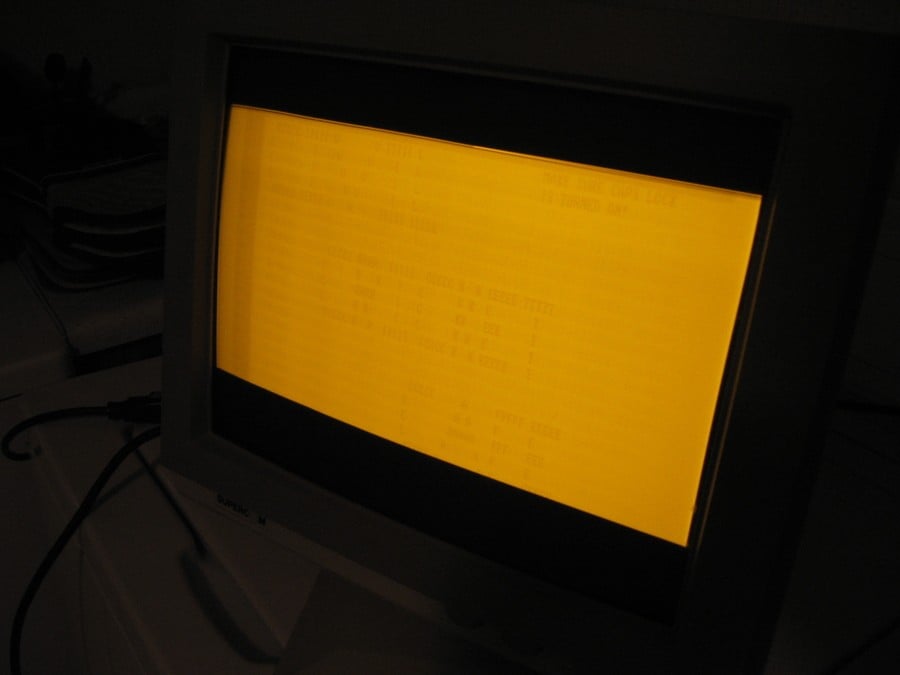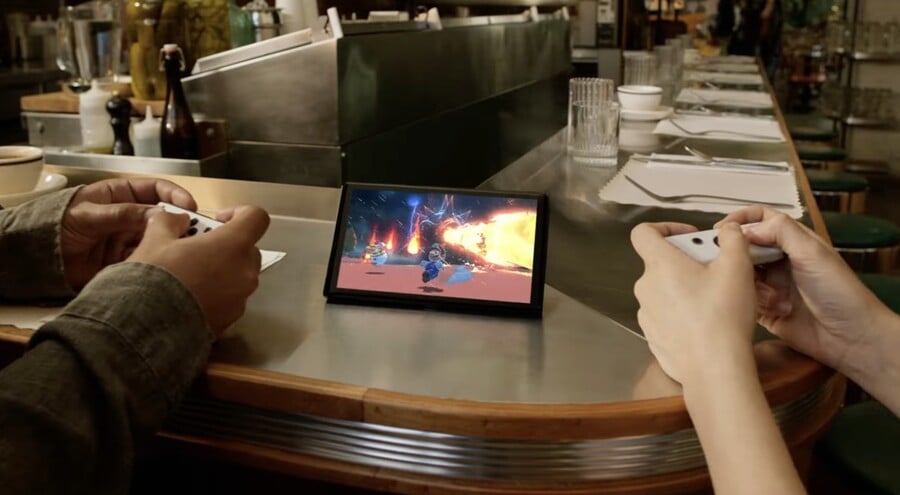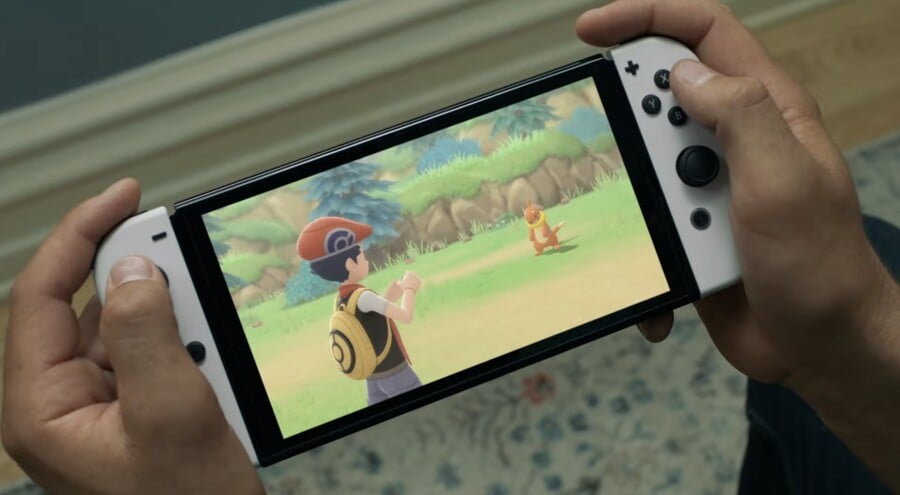
Editor's note: This piece was originally published when the Switch OLED was announced and has been updated with new content for the console's launch.
Now the Switch OLED is with us, it's perhaps worth revisiting the topic of screen burn-in. We know, thanks to Bloomberg, that the screen on the Switch OLED is supplied by Samsung, which has consistently led the way when it comes to OLED screen technology over the past decade or so.
That's one reason to perhaps feel confident that burn-in isn't going to be a massive problem with Nintendo's new console, but it's worth remembering that OLED panels have come a long way over the past few years.
"You don’t see a lot of burn-in in modern OLED panels because the displays have evolved to actively prevent it," Michael Helander tells us. Helander is President & CEO of OTI Lumionics, a leading developer of advanced materials for OLED displays, so it's safe to say that he knows what he's talking about.
"They record how long each pixel is turned on and compensate in the back-end hardware to combat against the effect of burn-in," he adds. "Nearly 10 years ago, the PlayStation Vita also came out with an OLED panel and received very little feedback in the way of burn-in. Even that was an older version of OLED, so you can imagine the newest OLED panels are equipped to tackle the original concerns while giving consumers the performance they expect from advanced displays."
While it doesn't seem as if Nintendo has employed any special software tricks to prevent burn-in on the Switch OLED, but it is at least offering advice on the matter. As spotted by The Verge, Nintendo includes the following warning in the Switch OLED's user manual:
To minimize the risk of image retention or screen burn-in occurring on the OLED screen, do not turn off the system’s default sleep mode settings and take care to not display the same image on the OLED screen for extended periods of time.
It's worth noting that image retention and burn-in aren't the same thing, although they're often mistaken for being the same. Image retention isn't permanent and goes away after a while.
Now the Switch OLED is here, are you still concerned about burn-in? Or are you confident it's not going to be an issue?
So, what's the problem exactly?
Burn-in can occur with various types of displays if they are made to show the same static image for long enough. It happens to phones, TVs, and generally anything with a screen. It's not just TikTok, either — the icons displaying battery, wifi, volume, and the fact that my phone is always set to vibrate are all there too, ghost-like apparitions on the top-right of my screen. On the left, there's a quite-creepy amalgam of every single time that I've looked at my phone, represented by a permanent spectral clock, plus an irritating reminder that I have way too many unread emails and messages, because there's all these notification-shapes up there too.

I have a Google Pixel 2XL, by the way, which — according to Wikipedia — has a P-OLED screen (the P, in case it's important to you, stands for "polymer"). Reports of screen burn-in on these phones were recorded as early as 2017, just months after it was released. Similarly, with the PlayStation Vita, many owners reported burn-in, especially if they left the screen on for long periods of time (i.e. while playing games, or leaving the console on pause).
So, of course, when the Nintendo Switch (OLED Model) was revealed to be largely the same as the old Switch, but with — you guessed it — an OLED screen, concern over burn-in began to spread.
As highlighted in CNET's piece about burn-in on TVs, manufacturers — from Apple to Google to LG — are aware of the curse of burn-in, and seem to respond largely by telling their customers how to avoid it, making fun of the companies that tell customers how to avoid it, or just flat-out denying that their TVs have the burn-in problem, despite evidence to the contrary.
One trend emerges: if you have screen burn-in, these companies say, it's your fault — for watching videos with static UI, or playing video games for too long. Just stop doing those things, and you won't have burn-in. I'm sorry, you want me to avoid video games with static UI? That's all of them. That's all the video games.

Now, manufacturers have started anticipating OLED from their side, rather than denying its existence. Apple's new iPhones have "special algorithms that monitor the usage of individual pixels to produce display calibration data," which is to say that it self-adjusts brightness to stop burn-in, although they say that burn-in is just an "expected behaviour" with OLED screens. It's a risk-reward thing, but you can mitigate the risk, at least.
Consoles, like the Xbox, try to reduce burn-in on their side by having things fade to a "dim" setting after a while. The current Switch has a "Screen Burn-In Reduction" mode too, which does a similar thing after five minutes of inactivity. These settings protect the user's TV from getting burn-in, even though that's not really the responsibility of the console manufacturers. Nice!
What does Nintendo say about burn-in on Switch OLED?

But the question is not "will the Switch leave burn-in on my OLED TV" but "will the Switch leave burn-in on itself". The new OLED screen is part of the console, and is clearly designed for better-looking handheld play. As someone who largely plays Switch in handheld mode, I want to know: Is it going to have perma-health bars and mini-maps seared into the screen?
Well, CNET isn't worried about burn-in on the Switch's OLED screen, at least. Here's the statement that Nintendo gave them:
"We've designed the OLED screen to aim for longevity as much as possible, but OLED displays can experience image retention if subjected to static visuals over a long period of time.
However, users can take preventative measures to preserve the screen [by] utilizing features included in the Nintendo Switch systems by default, such as auto-brightness function to prevent the screen from getting too bright, and the auto-sleep function to go into 'auto sleep' mode after short periods of time."
To summarise: they're not denying that burn-in is a problem, and their statement seems to imply that, yes, eventually, it might happen — but you can prevent (or postpone) the issue with careful usage of brightness levels and auto-sleep.
So, should I be worried about burn-in with the Switch OLED?
CNET themselves list a few things that have assuaged their fears about burn-in: first, different games have different static features, so unless you're playing the same game for hours, the OLED Switch will be fine. Plus, unlike phones, the Switch doesn't have an always-on menu element like battery or a clock, and it does have that automatic sleep mode that we mentioned.
But, of course, there are gamers that play the same games for hours at a time — games like Fortnite, Minecraft, or Tetris 99. Obviously, those players will be at a way higher risk of screen burn-in, and even Nintendo isn't denying that.
It should be said that OLED technology has advanced since the Vita days, as have built-in solutions and measures to mitigate the problem and improve the life of any screen you buy that's likely to get prolonged and daily use. That doesn't mean burn-in couldn't happen on your Switch OLED screen, but Nintendo will have anticipated the issue. We can't be certain until we spend significant time with the console — and goodness knows Nintendo doesn't have a perfect track record when it comes to hardware — but unless you go out of your way to induce burn-in by turning off the auto-brightness sensor and only ever playing for hours every day at 100% brightness, our gut feeling is that you'll probably be fine.
CNET puts it pretty succinctly, though: if you believe burn-in is likely, "don't buy the new Switch".

You are, in general, less likely to get burn-in on a console, even with the caveat that hours on one game could cause it to happen. My phone issue only started happening three years into my possession of it, and that's because I'm a trashbag who watches too many TikToks. My real punishment will be the roasting I get in the comments, no doubt. As for TVs, the problem becomes more likely when you have something like a news channel on a lot of the time, like TVs in receptions and waiting rooms.
We can't say for sure whether or not the OLED screen will have significant burn-in issues, because we aren't psychic, but the safest answer for now is that it's possible, under specific conditions. As pointed out by this Best Buy employee on Reddit, and by CNET, and by Nintendo themselves, there are precautions we can take to reduce the chance of it happening: don't leave the screen on full brightness for hours, especially not on a menu screen, and set the console to dim or auto-sleep after a few minutes of inaction.
Plus, there's always the option of not buying the new OLED Switch at all if you'd mostly be using it for really long Overwatch marathons in handheld mode. For some, the risk can be balanced against the reward of darker blacks, higher contrast, and brighter colours; for others, it's best to just stick to the trustworthy ol' LCD screen.
https://news.google.com/__i/rss/rd/articles/CBMicmh0dHBzOi8vd3d3Lm5pbnRlbmRvbGlmZS5jb20vbmV3cy8yMDIxLzEwL3RhbGtpbmctcG9pbnQtc2hvdWxkLXdlLWJlLXdvcnJpZWQtYWJvdXQtc2NyZWVuLWJ1cm4taW4td2l0aC1zd2l0Y2gtb2xlZNIBAA?oc=5
2021-10-11 15:50:00Z
52781927942169
Tidak ada komentar:
Posting Komentar